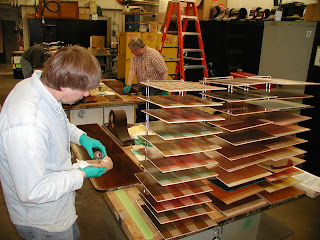

The Wood Finishing Technology Program taught by Mitch Kohanek and offered at Dakota County Technical College (DCTC)in Rosemount, MN.


 Cane chairs are not only beautiful but they evoke a sense of history and craftsmanship. There are two kinds of cane seats--those woven by hand with long strands of thin cane and those made of a machine-woven cane sheet. Even if all the original cane is gone from a chair, one tell which type of seat it had. If there is a narrow groove around the seat frame, the chair had machine-woven cane. For years cane chairs were made in the factories but sent out to weavers who would weave the cane seats and backs by hand. Eventually, machines began to do the weaving mechanically.
Cane chairs are not only beautiful but they evoke a sense of history and craftsmanship. There are two kinds of cane seats--those woven by hand with long strands of thin cane and those made of a machine-woven cane sheet. Even if all the original cane is gone from a chair, one tell which type of seat it had. If there is a narrow groove around the seat frame, the chair had machine-woven cane. For years cane chairs were made in the factories but sent out to weavers who would weave the cane seats and backs by hand. Eventually, machines began to do the weaving mechanically. Pre-woven cane makes re-caning a chair a much simpler process, but it still takes patience and a steady hand to bring old cane chairs back to life.
Pre-woven cane makes re-caning a chair a much simpler process, but it still takes patience and a steady hand to bring old cane chairs back to life. .JPG) Past NIWF graduate, and professional antique dealer, Seth Stevenson, came in today to talk about his business in dealing, refinishing, refurbishing and conservation of antiques. Seth was dealing in antiques before he came to DCTC, but decided to take his knowledge, skills, and abilities to the next level by attending the National Institute of Wood Finishing.
Past NIWF graduate, and professional antique dealer, Seth Stevenson, came in today to talk about his business in dealing, refinishing, refurbishing and conservation of antiques. Seth was dealing in antiques before he came to DCTC, but decided to take his knowledge, skills, and abilities to the next level by attending the National Institute of Wood Finishing..JPG) .
.
Tim Inman, from Randolph, Iowa was kind enough to join us to discuss restoration. Here he is showing the students techniques for restoring antique picture frames.
Tim has been in business doing refinishing since 1974. His company, Historic Interiors, offers both custom restoration services to individuals and businesses for antiques and other quality furniture items, including clocks, movements, picture frames, etc., as well as providing specialty products and training to the trade and other active hobbyists. They also make custom reproduction pieces as commissioned.
Tim has served as an advisory board member for the National Institute of Wood Finishing at Dakota County Technical College since the early 1980's
+wood+1019.JPG)
.JPG)
.JPG)
.JPG)
.JPG)
.JPG)
 When it comes to Advanced Finishing, it is so important to get lots of hands on experience. The students get about 20 boards that they must prep and finish using different materials and techniques. From crackle lacquer to varnish and shellac, from dying, staining and glazing; Advanced finishing give a hands on approach
When it comes to Advanced Finishing, it is so important to get lots of hands on experience. The students get about 20 boards that they must prep and finish using different materials and techniques. From crackle lacquer to varnish and shellac, from dying, staining and glazing; Advanced finishing give a hands on approach.JPG) to the use of many products wood finishers will encounter.
to the use of many products wood finishers will encounter.  This is a valuable skill for wood finishers because, if done well, any finisher should be able to look at a story board and re-create what has been done in the past without having to do a lot of guess work.
This is a valuable skill for wood finishers because, if done well, any finisher should be able to look at a story board and re-create what has been done in the past without having to do a lot of guess work.